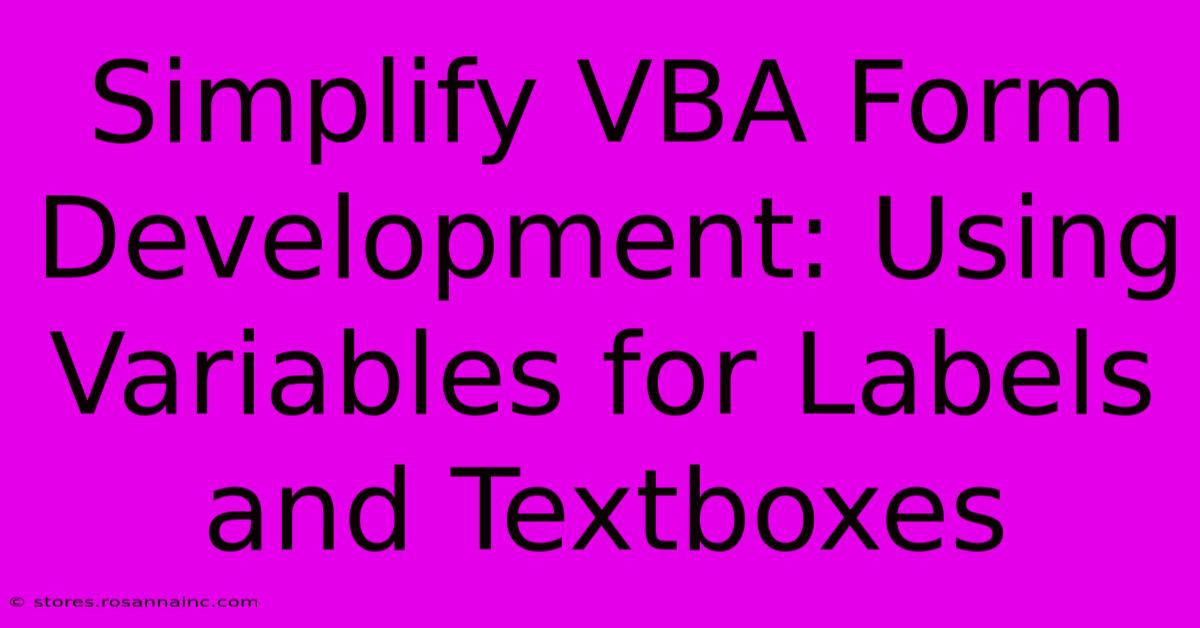Simplify VBA Form Development: Using Variables For Labels And Textboxes

Table of Contents
Simplify VBA Form Development: Using Variables for Labels and Textboxes
Developing user forms in VBA can sometimes feel like navigating a maze. Manually assigning names to each control and then referencing them throughout your code is tedious and error-prone. This article will show you how to dramatically simplify your VBA form development by using variables to dynamically manage your labels and textboxes. This technique makes your code cleaner, more efficient, and easier to maintain.
The Problem with Manual Control Referencing
Imagine building a form with dozens of textboxes and labels. Each needs a unique name (e.g., TextBox1, Label1, TextBox2, Label2, etc.). Your code then becomes littered with these specific names, making it difficult to read, modify, and debug. A small change—like adding a single control—requires updating numerous lines of code. This is where variable assignment becomes invaluable.
The Power of Variables: Dynamic Control Management
By assigning variables to your controls, you decouple your code from the specific names of the controls themselves. This allows you to manipulate them more easily and efficiently. Let's illustrate with an example.
Suppose you have a form with several text boxes collecting user data for a customer. Instead of directly referencing TextBox1, TextBox2, and TextBox3 for customer name, address, and phone number, we'll use variables:
Dim txtName As MSForms.TextBox
Dim txtAddress As MSForms.TextBox
Dim txtPhone As MSForms.TextBox
' Assign variables to the controls on your form. This assumes your form is named "UserForm1".
Set txtName = UserForm1.Controls("txtName")
Set txtAddress = UserForm1.Controls("txtAddress")
Set txtPhone = UserForm1.Controls("txtPhone")
' Now you can use the variables to access and manipulate the controls:
txtName.Value = "John Doe"
txtAddress.Value = "123 Main Street"
txtPhone.Value = "555-1212"
' Displaying information is much cleaner:
MsgBox "Customer Name: " & txtName.Value
See how much cleaner this code is? Adding a new field, for example, email, simply involves adding a new variable and assigning it the appropriate control on the form. You don't need to change the existing code.
Looping Through Controls: Ultimate Efficiency
The real power of this approach shines when dealing with a large number of controls. You can use loops to process them efficiently. Let's say you want to clear all the textboxes on your form:
Dim ctrl As MSForms.Control
For Each ctrl In UserForm1.Controls
If TypeName(ctrl) = "TextBox" Then
ctrl.Value = ""
End If
Next ctrl
This code iterates through all controls on the form and only clears the value of textboxes. This is far more efficient and maintainable than individually clearing each textbox by name.
Best Practices for Variable Naming
For optimal readability and maintainability:
- Descriptive Names: Use names that clearly indicate the control's purpose (e.g.,
txtName,txtAddress, nottxt1,txt2). - Consistent Prefix: Using a consistent prefix (e.g.,
txtfor textboxes,lblfor labels) enhances readability and helps you quickly identify control types. - Error Handling: Always include error handling (e.g.,
On Error Resume Next) when working with controls, to gracefully handle situations where a control might not exist.
Conclusion: Streamlining Your VBA Form Development
Using variables for your VBA form controls significantly improves code clarity, reduces the risk of errors, and makes your forms easier to maintain and expand. This simple technique will save you time and frustration in the long run, empowering you to build more robust and sophisticated VBA applications. Adopt this approach and witness the difference in your form development workflow! You'll wonder why you didn't start using it sooner.

Thank you for visiting our website wich cover about Simplify VBA Form Development: Using Variables For Labels And Textboxes. We hope the information provided has been useful to you. Feel free to contact us if you have any questions or need further assistance. See you next time and dont miss to bookmark.
Featured Posts
-
No Mas Texto No Deseado Elimina Cualquier Caracteres De Tus Fotos
Feb 06, 2025
-
Unveiling The Mystery Why Does Your Cursor Insist On Joining Tables
Feb 06, 2025
-
Raider Rush Vs Other Nfl Mascots Who Reigns Supreme
Feb 06, 2025
-
The Holy Grail Of Mail Hosting Discover The Platform That Will Conquer 2024
Feb 06, 2025
-
The Floral Canvas Transform Your Wedding Tables With Ethereal Centerpieces
Feb 06, 2025
